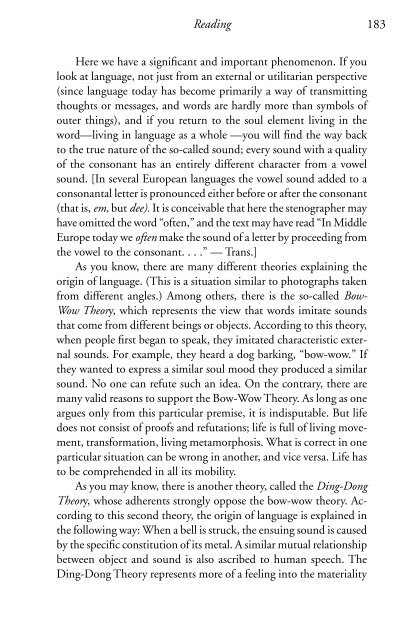Teaching Language arTs in The WaLdorf schooL
Teaching Language arTs in The WaLdorf schooL
Teaching Language arTs in The WaLdorf schooL
Create successful ePaper yourself
Turn your PDF publications into a flip-book with our unique Google optimized e-Paper software.
Read<strong>in</strong>g<br />
183<br />
Here we have a significant and important phenomenon. If you<br />
look at language, not just from an external or utilitarian perspective<br />
(s<strong>in</strong>ce language today has become primarily a way of transmitt<strong>in</strong>g<br />
thoughts or messages, and words are hardly more than symbols of<br />
outer th<strong>in</strong>gs), and if you return to the soul element liv<strong>in</strong>g <strong>in</strong> the<br />
word—liv<strong>in</strong>g <strong>in</strong> language as a whole —you will f<strong>in</strong>d the way back<br />
to the true nature of the so-called sound; every sound with a quality<br />
of the consonant has an entirely different character from a vowel<br />
sound. [In several European languages the vowel sound added to a<br />
consonantal letter is pronounced either before or after the consonant<br />
(that is, em, but dee). It is conceivable that here the stenographer may<br />
have omitted the word “often,” and the text may have read “In Middle<br />
Europe today we often make the sound of a letter by proceed<strong>in</strong>g from<br />
the vowel to the consonant. . . .” — Trans.]<br />
As you know, there are many different theories expla<strong>in</strong><strong>in</strong>g the<br />
orig<strong>in</strong> of language. (This is a situation similar to photographs taken<br />
from different angles.) Among others, there is the so-called Bow-<br />
Wow <strong>The</strong>ory, which represents the view that words imitate sounds<br />
that come from different be<strong>in</strong>gs or objects. Accord<strong>in</strong>g to this theory,<br />
when people first began to speak, they imitated characteristic external<br />
sounds. For example, they heard a dog bark<strong>in</strong>g, “bow-wow.” If<br />
they wanted to express a similar soul mood they produced a similar<br />
sound. No one can refute such an idea. On the contrary, there are<br />
many valid reasons to support the Bow-Wow <strong>The</strong>ory. As long as one<br />
argues only from this particular premise, it is <strong>in</strong>disputable. But life<br />
does not consist of proofs and refutations; life is full of liv<strong>in</strong>g movement,<br />
transformation, liv<strong>in</strong>g metamorphosis. What is correct <strong>in</strong> one<br />
particular situation can be wrong <strong>in</strong> another, and vice versa. Life has<br />
to be comprehended <strong>in</strong> all its mobility.<br />
As you may know, there is another theory, called the D<strong>in</strong>g-Dong<br />
<strong>The</strong>ory, whose adherents strongly oppose the bow-wow theory. Accord<strong>in</strong>g<br />
to this second theory, the orig<strong>in</strong> of language is expla<strong>in</strong>ed <strong>in</strong><br />
the follow<strong>in</strong>g way: When a bell is struck, the ensu<strong>in</strong>g sound is caused<br />
by the specific constitution of its metal. A similar mutual relationship<br />
between object and sound is also ascribed to human speech. <strong>The</strong><br />
D<strong>in</strong>g-Dong <strong>The</strong>ory represents more of a feel<strong>in</strong>g <strong>in</strong>to the materiality

















